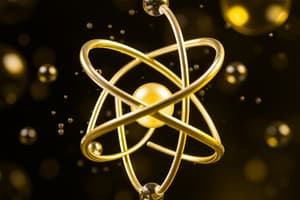Podcast
Questions and Answers
Which relationship is true of an uncharged atom?
Which relationship is true of an uncharged atom?
- The number of protons is less than the number of electrons
- The number of protons is greater than the number of electrons
- The number of protons is equal to the number of electrons (correct)
- The number of neutrons is equal to the number of protons
What determines the types of chemical reactions that an atom participates in?
What determines the types of chemical reactions that an atom participates in?
The number of electrons in the outermost electron shell.
Which of these refers to atoms with the same atomic number but different atomic masses?
Which of these refers to atoms with the same atomic number but different atomic masses?
Isotopes.
Fluorine's atomic number is 9 and its atomic mass is 19. How many neutrons does fluorine have?
Fluorine's atomic number is 9 and its atomic mass is 19. How many neutrons does fluorine have?
An uncharged atom of boron has an atomic number of 5 and an atomic mass of 11. How many protons does boron have?
An uncharged atom of boron has an atomic number of 5 and an atomic mass of 11. How many protons does boron have?
Flashcards are hidden until you start studying
Study Notes
Atomic Relationships
- An uncharged atom maintains an equal number of protons and electrons, ensuring electrical neutrality.
- The atomic number of an element, which is the number of protons, also indicates the number of electrons in an uncharged state.
Chemical Reactions
- The types of chemical reactions an atom can engage in are determined by the electrons present in its outermost shell, known as the valence electrons.
Isotopes
- Isotopes are variants of elements that share the same atomic number (number of protons) but differ in atomic mass due to differing numbers of neutrons.
Neutron Calculation
- Fluorine, with an atomic number of 9 and an atomic mass of 19, contains 10 neutrons calculated as: atomic mass - atomic number = 19 - 9.
Boron Atomic Structure
- Boron has an atomic number of 5, indicating it possesses 5 protons, which is also the same number of electrons in a neutral atom. Its atomic mass is 11, implying it has 6 neutrons.
Studying That Suits You
Use AI to generate personalized quizzes and flashcards to suit your learning preferences.




